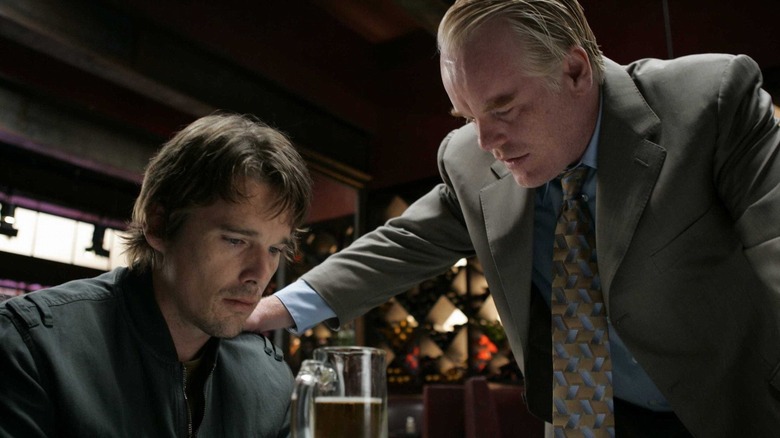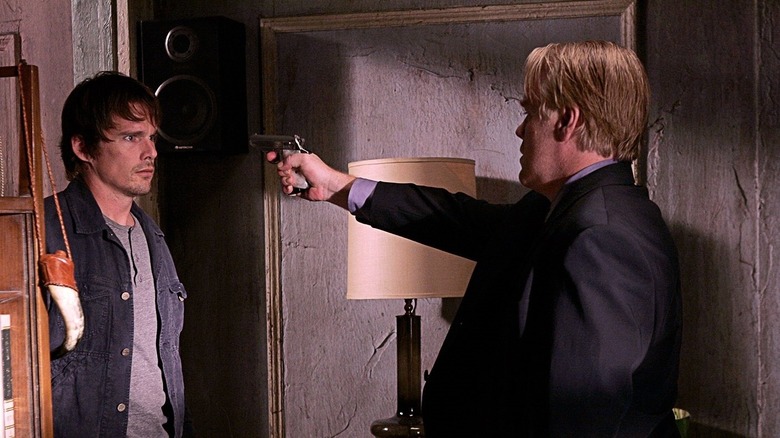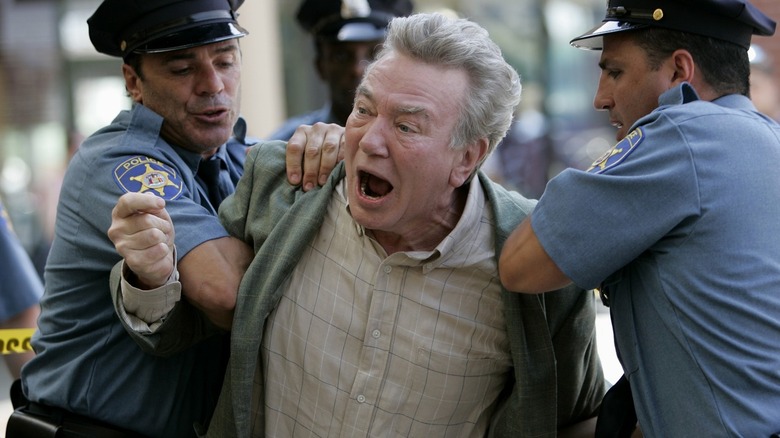Why Sidney Lumet Championed The Shift Away From Shooting Movies On Film
At the end of 2011, the number of digital projectors in movie theaters officially surpassed the number of analog film projectors. This was the final step in a years-long technological revolution that had been raging for the better part of a decade. In the early 2000s, digital film — while looking grainy and amateurish at the time — was touted as the Next Big Thing, and many companies began to slowly make the shift. Anyone who saw "Star Wars: Episode II — Attack of the Clones" in theaters likely recalls the grainy, dim quality of digital projection at the time.
In Christopher Keneally's 2012 documentary film "Side by Side," Keanu Reeves interviews a spate of experienced filmmakers on the general state of film technology, and many of them, perhaps surprisingly, came down in favor of digital photography. David Lynch declared that film was a dinosaur. It looked beautiful but moved too slowly to facilitate streamlined filmmaking the way he preferred. Martin Scorsese was diplomatic, saying that 35mm film was gorgeous, but that digital will have its place.
Indeed, many established filmmakers started coming out in favor of digital, perhaps irking a new generation of hipster cineastes (and, dear reader, this writer was most certainly of that crowd) who very much preferred the heft and old-world quality of a nice 35mm film print. (This writer has since changed his tune.) In a 2012 article on The Verge, David Cronenberg even declared that digital was not only superior but that he had no particular affection for film. He even once argued that skipping around to one's favorite scenes on a DVD was the best way to watch a movie.
Generally speaking, younger filmmakers skewed toward the dynamism of film. Their elders preferred the ease of digital.
Lumet's opinion
Very much in favor of the switch to digital filmmaking was Sidney Lumet, the director of "12 Angry Men," "Dog Day Afternoon," "Network," "The Wiz," "The Verdict," and many other notable classics besides. In a 2007 interview with DGA Quarterly, Lumet announced quite proudly that was an early adopter of digital cameras, and that the revolution was already well underway.
By 2007, it should be noted, digital features were already quite common. In addition to two "Star Wars" blockbusters, an increasing number of acclaimed indie dramas were already shot on digital cameras; Lars Von Trier's "Dogville," Michael Mann's "Collateral," Robert Rodriguez's "Spy Kids," and Steven Soderbergh's "Bubble" all proved that a new cinematic aesthetic was forming and that skilled filmmakers were going to ply it. It would be in 2008 that a mostly digitally-shot film — "Slumdog Millionaire" — would first win an Academy Award for Best Cinematography.
Lumet wanted to address the widespread metaphorical handwringing that purists had been doing over the technological shift. When asked if image quality and fidelity were an issue, Lumet brushed the question off, saying:
"It's that perennial fear of something new. You can get not only great image quality — although I must say I'd like to see the pixels increased, but that's a very simple adjustment and, even now, it's certainly passable. But there are certain things that are already so superior to film. Your focal depth — just no comparison."
Lumet had just filmed "Before the Devil Knows Your Dead" digitally with cinematographer Ron Fortunato.
The question about image quality was based on the fact that 2K digital cameras couldn't capture as much visual information as 35mm film. 4K digital projection, incidentally, contained far more information than 35mm film.
Film never looked real
Lumet also makes the argument that films, as most audiences have come to accept them, never looked like reality. Lumet indicates that most films possess an element of artificiality that celluloid film seemingly demanded. Given the lighting and the color schemes of classic Hollywood, realism never appeared to be the goal. Lumet preferred a sense of visual verisimilitude. The only thing preventing an appreciative audience from enjoying a digitally photographed film, according to Lumet, was that they had been trained to accept "fake" film color as real. It's not. He argued:
"[T]he additional advantages: For example, a movie like 'Dog Day Afternoon,' where your first obligation is to put across the idea that, 'Hey folks, this really happened.' This picture is nothing if it's an invented picture. It's only interesting, and true, because of the reality of it. Well, we were killing ourselves trying to get film to look real. Because film color is not real. And we accept it because we have to and because we're used to it. The sky is not the blue that you see on film. And the green grass is not the green you see on film."
Lumet punctuates his point with a story about running into Michelangelo Antonioni in London during the shooting of the 1966 film "Blow-Up." Antonioni, the story goes, was painting the grass greener than it was. When Lumet asked what he was doing, Antonioni replied that he needed the grass to be "real green."
Lumet, sadly, only shot one feature in digital before his death in 2011 at the age of 86. By then, the film world had already shifted largely to digital. The man, it seems, was ahead of his time.


